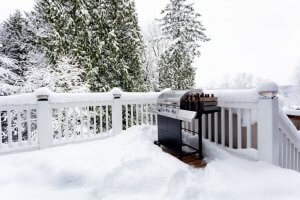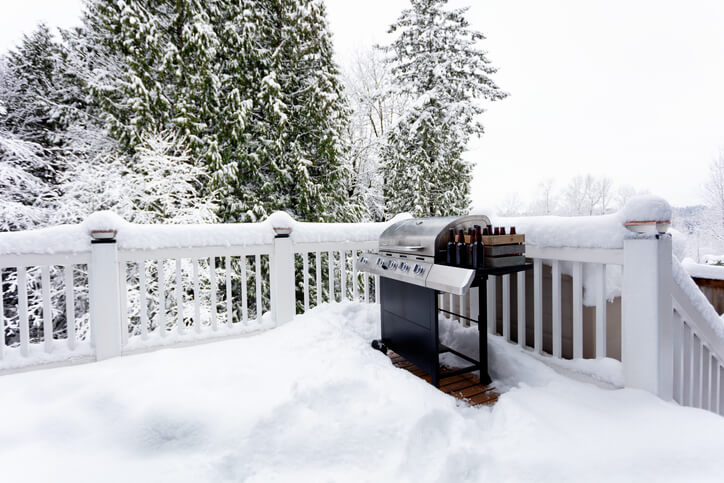How to Weatherproof Your Outdoor Kitchen for Pittsburgh Winters
Pittsburgh’s winters are long, cold, and often unpredictable. One day may bring flurries and mild wind, while the next could dump several inches of snow and plunge temperatures into the teens. While your home’s interior stays warm and cozy, your outdoor kitchen remains exposed to the elements. Without proper design and maintenance, winter can take a toll on your beautiful investment, cracking countertops, rusting appliances, and warping cabinets.
At Treesdale Landscape Company, we specialize in designing and installing outdoor kitchens that are built to thrive in Western Pennsylvania’s four-season climate. Whether you’re planning a new build or want to protect your existing outdoor kitchen, this guide covers everything you need to know to weatherproof your outdoor kitchen for the harshest Pittsburgh winters.
Why Winterizing Matters for Outdoor Kitchens

An outdoor kitchen is more than just a grill on the patio. Today’s designs often include sinks, refrigerators, cabinetry, pizza ovens, and stone countertops, making them as functional and stylish as your indoor space. But all these features require protection when cold weather arrives.
Failing to winterize can lead to:
- Cracked pipes and damaged plumbing
- Rusted or corroded appliances
- Mold or mildew buildup from trapped moisture
- Warped or rotted cabinetry
- Shortened lifespan of your entire installation
Preparing now can save you thousands in repairs or replacement costs down the line.
1. Choose Durable, Weather-Resistant Cabinetry
Cabinetry is often the most vulnerable part of an outdoor kitchen. It’s exposed to moisture, temperature fluctuations, and even UV rays during the warmer months. For an outdoor kitchen that can hold up to winter weather, select materials that are specifically engineered to withstand outdoor conditions year-round.
Top choices include:
Marine-grade polymer: Highly durable and non-porous, this material won’t crack, warp, or absorb moisture—even in freezing rain or heavy snow.
Stainless steel with a powder-coated finish: The powder coating protects against rust and corrosion, giving your cabinets a sleek look with industrial-level durability.
Sealed natural stone or masonry: When properly sealed and maintained, it offers timeless beauty and excellent resistance to the elements.
Avoid: Wood cabinets, even those labeled as weather-resistant, are prone to moisture absorption, leading to expansion, rot, and eventual breakdown. In Pittsburgh’s wet, icy climate, they don’t hold up over time.
2. Add Protective Overhead Structures
Overhead structures like pergolas, pavilions, and gazebos are not only visually striking but also vital for protecting your kitchen from snow, ice, and rain.
Benefits of covered structures:
- Shield appliances from direct snowfall and freezing rain
- Extend the life of countertops and cabinetry.
- Create year-round usability with integrated lighting and heating.
- Offer shade and shelter.
At Treesdale, we design custom structures that blend seamlessly with your home’s architecture and landscape. Whether it’s a rustic wood pergola with stone columns or a fully enclosed pavilion, overhead coverage is one of the best long-term investments you can make for your outdoor kitchen.
3. Install Smart Heating Solutions
Who says grilling is just for summer? With the right heating features, your outdoor kitchen can remain usable into fall and even during mild winter days.
Popular cold-weather heating options:
Infrared patio heaters: Mounted overhead or on walls, these efficient heaters deliver direct warmth, making covered patios toasty even when the air is chilly.
Gas fireplaces or fire pits: Create ambiance and offer centralized warmth for lounging and dining areas. Ideal for entertaining.
Radiant heated flooring: An advanced (but luxurious) solution that keeps walking areas clear of snow and ice, while adding an element of comfort and safety.
When paired with enclosures or windbreaks, these solutions can transform your space into a true four-season retreat.
4. Perform Seasonal Maintenance Before the First Freeze
Even a well-designed outdoor kitchen requires seasonal care. Before Pittsburgh’s first hard freeze—typically late October to early November—it’s essential to shut down, clean, and protect your space.
Cold-weather maintenance checklist:
Drain water lines and shut off valves: This includes outdoor sinks, ice makers, and beverage centers. Frozen water lines can crack or burst, leading to costly leaks.
Deep-clean appliances: Remove grease, food debris, and moisture to prevent rust and corrosion. Use stainless steel cleaners and degreasers as needed.
Cover all appliances: Invest in breathable covers (never plastic) that repel moisture while allowing air circulation. This prevents condensation buildup and mold.
Store accessories indoors: Remove cutting boards, fabric cushions, propane tanks, and smaller appliances like blenders or pizza stones. Store them in a dry, temperature-controlled space.
5. Consider Seasonal Upgrades for Ultimate Protection
If you plan to use your outdoor space year-round or want to maximize its longevity, seasonal upgrades can add comfort and security.
Ideas for winterproofing enhancements:
Retractable screens or weather curtains: Block wind and snow while maintaining a connection to the outdoors.
Built-in storage benches: Offer hidden compartments to store seasonal accessories when not in use.
Permanent heating features: Fireplaces, radiant heat, or overhead infrared panels can be incorporated for seamless comfort.
Snow-melt systems for walkways: Useful for keeping pathways clear.
These options not only make your kitchen more functional during winter, they also add value to your home and increase year-round enjoyment.
6. Design With Pittsburgh in Mind From the Start
The most effective winterization begins before your outdoor kitchen is even built. Treesdale Landscape Company designs every kitchen with Pittsburgh’s seasonal extremes in mind. We choose weather-hardy materials, use frost-protected footings, and incorporate drainage solutions that keep your space safe and functional, even in freezing conditions.
Our full-service design process includes:
- Site assessment and consultation
- Custom 3D designs and material selection
- Integrated structures, lighting, and heating
- Installation by certified professionals
- Ongoing seasonal service and maintenance
Why Trust Treesdale Landscape Company?
With decades of experience serving Western PA, we know how to create outdoor kitchens that are not only beautiful but also durable, weatherproof, and built to last. Our team uses region-specific expertise, premium materials, and a personalized approach to deliver outdoor spaces that stand up to snow, sun, and everything in between.
Schedule Your Design Consultation Today
Don’t let winter ruin your outdoor investment. A little planning now can help preserve your kitchen’s beauty, function, and value.
Call Treesdale Landscape Company today to start designing your dream outdoor kitchen—one that’s as enjoyable in January as it is in July.
- Best Materials for Outdoor Kitchens in Western Pennsylvania - November 10, 2025
- Modular vs. Custom Outdoor Kitchens: What’s Right for You? - November 10, 2025
- How to Weatherproof Your Outdoor Kitchen for Pittsburgh Winters - November 10, 2025






